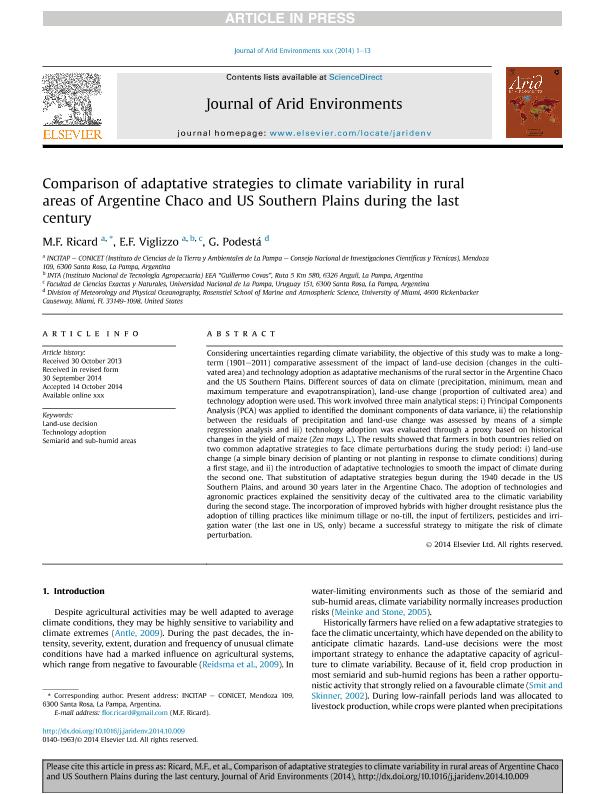Mostrar el registro sencillo del ítem
dc.contributor.author
Ricard, Maria Florencia

dc.contributor.author
Viglizzo, Ernesto Francisco

dc.contributor.author
Podestá, Guillermo Pablo

dc.date.available
2017-06-29T19:26:08Z
dc.date.issued
2015-12
dc.identifier.citation
Ricard, Maria Florencia; Viglizzo, Ernesto Francisco; Podestá, Guillermo Pablo; Comparison of adaptative strategies to climate variability in rural areas of Argentine Chaco and US Southern Plains during the last century; Elsevier; Journal of Arid Environments; 123; 12-2015; 68-80
dc.identifier.issn
0140-1963
dc.identifier.uri
http://hdl.handle.net/11336/19176
dc.description.abstract
Considering uncertainties regarding climate variability, the objective of this study was to make a long-term (1901–2011) comparative assessment of the impact of land-use decision (changes in the cultivated area) and technology adoption as adaptative mechanisms of the rural sector in the Argentine Chaco and the US Southern Plains. Different sources of data on climate (precipitation, minimum, mean and maximum temperature and evapotranspiration), land-use change (proportion of cultivated area) and technology adoption were used. This work involved three main analytical steps: i) Principal Components Analysis (PCA) was applied to identified the dominant components of data variance, ii) the relationship between the residuals of precipitation and land-use change was assessed by means of a simple regression analysis and iii) technology adoption was evaluated through a proxy based on historical changes in the yield of maize (Zea mays L.). The results showed that farmers in both countries relied on two common adaptative strategies to face climate perturbations during the study period: i) land-use change (a simple binary decision of planting or not planting in response to climate conditions) during a first stage, and ii) the introduction of adaptative technologies to smooth the impact of climate during the second one. That substitution of adaptative strategies begun during the 1940 decade in the US Southern Plains, and around 30 years later in the Argentine Chaco. The adoption of technologies and agronomic practices explained the sensitivity decay of the cultivated area to the climatic variability during the second stage. The incorporation of improved hybrids with higher drought resistance plus the adoption of tilling practices like minimum tillage or no-till, the input of fertilizers, pesticides and irrigation water (the last one in US, only) became a successful strategy to mitigate the risk of climate perturbation.
dc.format
application/pdf
dc.language.iso
eng
dc.publisher
Elsevier

dc.rights
info:eu-repo/semantics/openAccess
dc.rights.uri
https://creativecommons.org/licenses/by-nc-sa/2.5/ar/
dc.subject
Land-Use Decision
dc.subject
Technology Adoption
dc.subject
Semiarid And Sub-Humid Areas
dc.subject.classification
Otras Ciencias Agrícolas

dc.subject.classification
Otras Ciencias Agrícolas

dc.subject.classification
CIENCIAS AGRÍCOLAS

dc.title
Comparison of adaptative strategies to climate variability in rural areas of Argentine Chaco and US Southern Plains during the last century
dc.type
info:eu-repo/semantics/article
dc.type
info:ar-repo/semantics/artículo
dc.type
info:eu-repo/semantics/publishedVersion
dc.date.updated
2017-06-29T13:58:00Z
dc.journal.volume
123
dc.journal.pagination
68-80
dc.journal.pais
Países Bajos

dc.journal.ciudad
Ámsterdam
dc.description.fil
Fil: Ricard, Maria Florencia. Consejo Nacional de Investigaciones Científicas y Técnicas. Instituto de Ciencias de la Tierra y Ambientales de La Pampa. Universidad Nacional de La Pampa. Facultad de Ciencias Exactas y Naturales. Instituto de Ciencias de la Tierra y Ambientales de La Pampa; Argentina
dc.description.fil
Fil: Viglizzo, Ernesto Francisco. Consejo Nacional de Investigaciones Científicas y Técnicas. Instituto de Ciencias de la Tierra y Ambientales de La Pampa. Universidad Nacional de La Pampa. Facultad de Ciencias Exactas y Naturales. Instituto de Ciencias de la Tierra y Ambientales de La Pampa; Argentina. Instituto Nacional de Tecnología Agropecuaria. Centro Regional La Pampa-San Luis. Estación Experimental Agropecuaria Anguil; Argentina. Universidad Nacional de La Pampa. Facultad de Ciencias Exactas y Naturales; Argentina
dc.description.fil
Fil: Podestá, Guillermo Pablo. University of Miami; Estados Unidos
dc.journal.title
Journal of Arid Environments

dc.relation.alternativeid
info:eu-repo/semantics/altIdentifier/doi/http://dx.doi.org/10.1016/j.jaridenv.2014.10.009
dc.relation.alternativeid
info:eu-repo/semantics/altIdentifier/url/http://www.sciencedirect.com/science/article/pii/S0140196314002043?via%3Dihub
Archivos asociados
